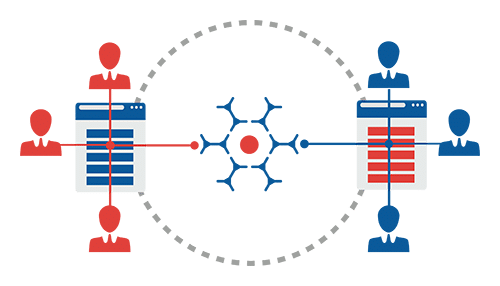
Go-to Microsoft partner for requirements management since 2015

Supported Sync Bridges
We know that teams use a wide variety of tools to support their requirements management processes. This is why we support some of the most popular Sync Bridges around.
Connect your favorite application with Azure DevOps!
- Synchronize data between Azure DevOps and other systems like Jira, DOORS and many others.
- Sync can be configured to be unidirectional or bidirectional.
- Sync frequency is configurable.

Choose the supported sync solution that's right for you!
Why Use a Sync Bridge?
As clients strive for more agility and a streamlined Dev OPS environment, having seamless, automated information exchanges between key systems in their ALM ecosystem becomes increasingly imperative.
Modern Requirements recognizes this need and has partnered with three leading Sync Bridge providers to sell and support their solutions.
Synchronization of information between the Modern Requirements4DevOps’ database and dozens of industry-leading ALM ecosystem applications are available out of the box, and can be tailored to meet the specific needs of each client.
What is a Sync Bridge?
A Sync Bridge is a software application that connects Azure DevOps and other applications in your ALM ecosystem.
A Sync Bridge can set up as unidirectional or bidirectional, and operates in the background, synchronizing desired information at user-defined times. Support for defects, requirements, work items, test cases, test plans, test results, tasks, suggestions, features, use cases, user stories and many more custom entities can be established in the mapping file. Relationships/ links between entities are maintained during synchronization, while “Change history” is preserved. No additional requirements for Azure DevOps are needed to support this type of integration.
Data Migration from your “to be retired” ALM tool to Azure DevOps is also possible on a project basis.
Synchronization
The Sync Bridge supports unidirectional and bidirectional synchronization between integrated ALM systems:
Unidirectional enables data to flow in one direction, such as in a master/slave model. In this model, you want one system to be the master and distribute information to other systems for read-only consumption.
Bidirectional synchronization enables changes to be made in any of the integrated systems. It’s ideal for allowing functional groups to use the ALM system that best meets their individual needs.
Deployment Options
The Sync Bridge has deployment options to fit the needs of your business:
On-Premise: The Sync Bridge can be installed as an on-premise solution to become a fully integrated component in your infrastructure.
Cloud: The Sync Bridge can be installed in a cloud environment, in Microsoft Azure.
History preservation
The Sync Bridge ensures that a complete history of your ALM activities is maintained as the entities flow between your integrated ALM systems. This ensures that you always have a complete picture and are compliant with applicable regulations.
History is maintained even when one of your individual systems becomes unavailable. Once the system is operational again, all transactions that occurred during that time will be reflected in the operating system.
Web based administration
Administrators will be able to manage their environment via the web-based administration tool. The web-based administration tool enables administrators to:
- Define entity synchronization between ALM systems
- Define business rules
- Define workflow management
- Perform failure management
Contact Us!
We believe in building comprehensive products and robust relationships. Visit our contact us page to contact us, or visit our product page to see what we have in store!


